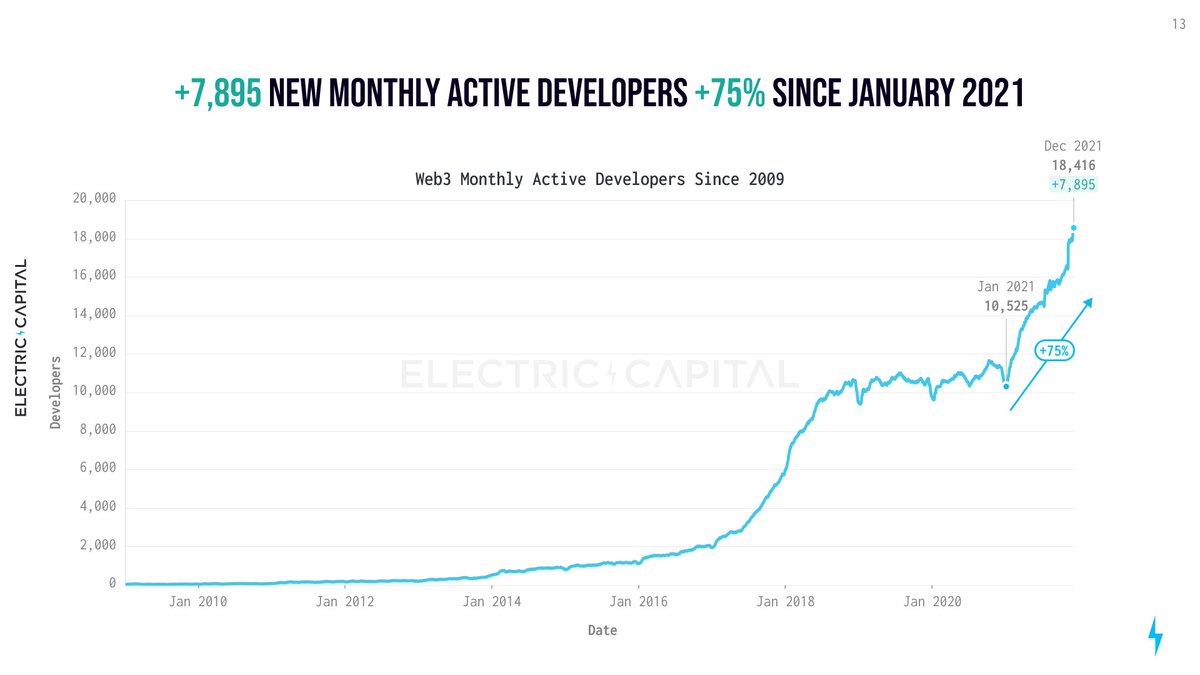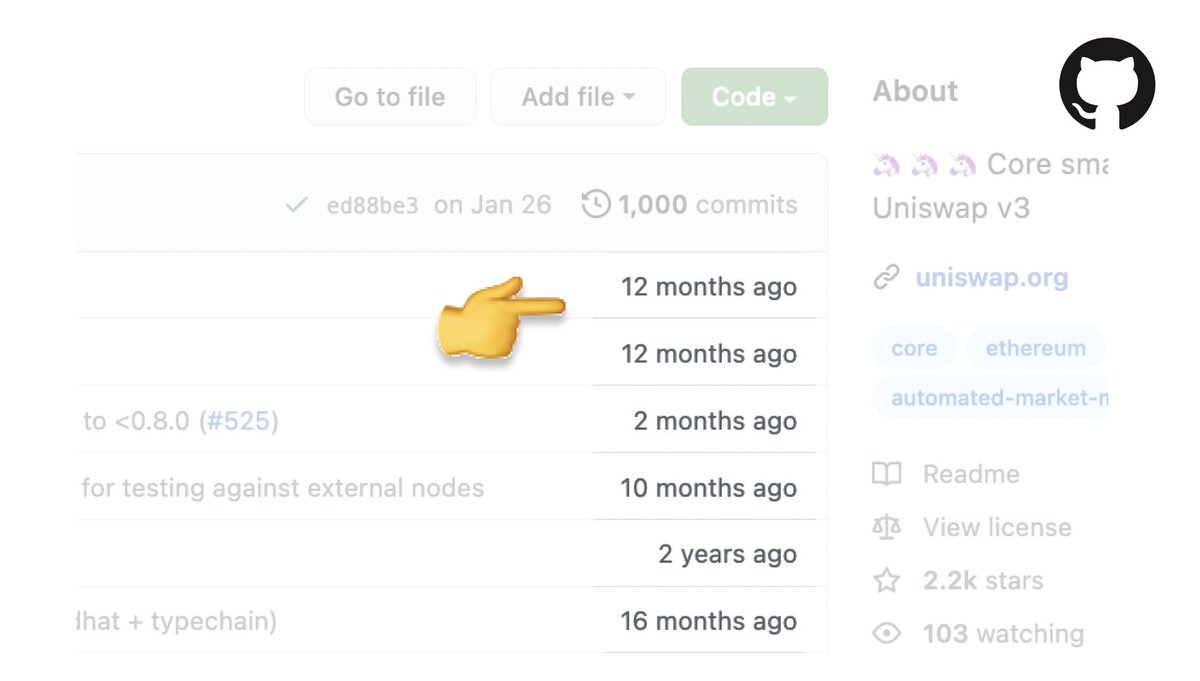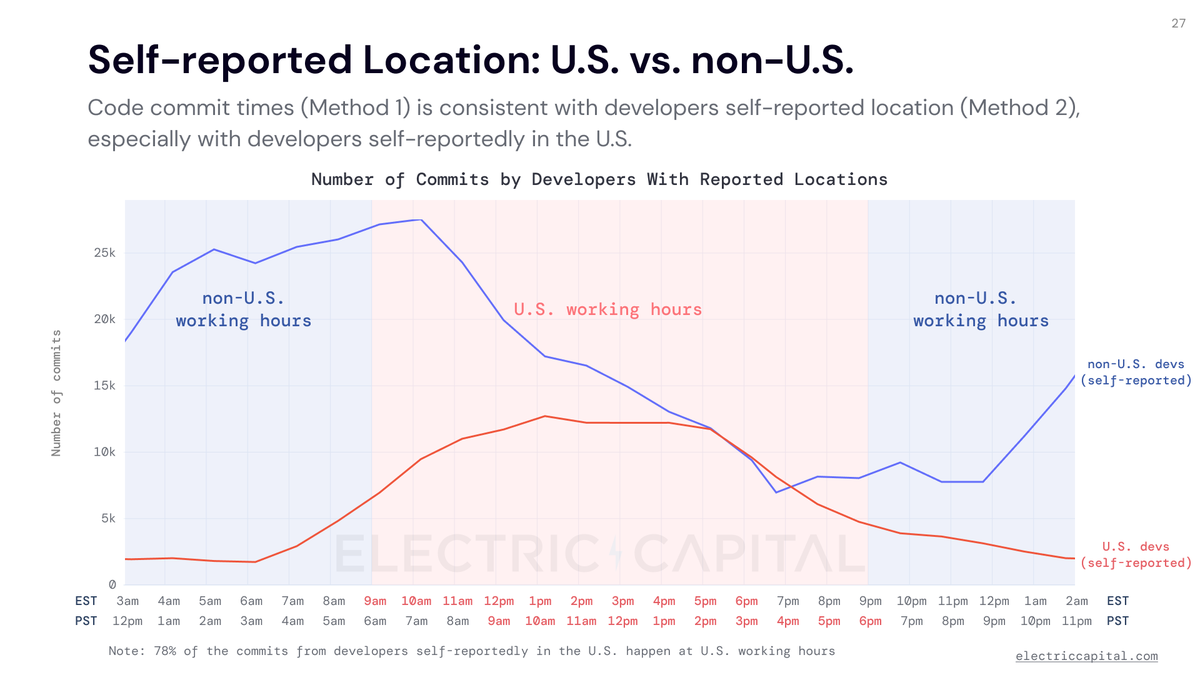1/ The US is losing its lead in web3 development.
@ElectricCapital classified the location of 5000+ web3 developers using our developer data + social profiles.
🧵 Let's see how fast the rest of the world is outpacing the US. 🌐🏃♀️👇
@ElectricCapital classified the location of 5000+ web3 developers using our developer data + social profiles.
🧵 Let's see how fast the rest of the world is outpacing the US. 🌐🏃♀️👇
2/ The web3 ecosystem is growing like never before:
18k+ monthly open source devs per @ElectricCapital's 2021 Developer Report!
18k undercounts overall devs because it does not count closed source.
Which countries are bringing more devs to web3?
18k+ monthly open source devs per @ElectricCapital's 2021 Developer Report!
18k undercounts overall devs because it does not count closed source.
Which countries are bringing more devs to web3?

3/ We use 2 methods to infer the location of developers:
#1: code submission timestamps (assuming devs in US submit between 9am EST - 10pm EST)
#2: social profiles linked with developer profiles on platforms like GitHub


#1: code submission timestamps (assuming devs in US submit between 9am EST - 10pm EST)
#2: social profiles linked with developer profiles on platforms like GitHub



4/ We defined the US working hours window to be 9am EST - 10pm EST. This likely overcounts US devs as we cannot exclude Canada or LatAm using only time zones.
This gif shows how *more* work is happening during non-US working hours.
This gif shows how *more* work is happening during non-US working hours.
5/ If we plot the historical share of code submission happening during US working hours, then we see that the US share declined from 65% in 2012 to 55% in 2022 YTD. 

6/ For reference, we can measure the historical US market share in well-established open source projects using the same time zone methodology.
Code repositories like those of Go or Linux have a more constant share of activity during US working hours.

Code repositories like those of Go or Linux have a more constant share of activity during US working hours.


7/ How reasonable are code timestamps for the windows we used to approximate activity within the US?
As expected, known US-based ecosystems have more commits during US working hours. For known non-US ecosystems, we see a bigger overlap with non-US working hours.


As expected, known US-based ecosystems have more commits during US working hours. For known non-US ecosystems, we see a bigger overlap with non-US working hours.



8/ Code timestamps have limitations:
1# US working hours are shared across countries in the Americas
2# Many US-based web3 engineers work outside standard working hours
To cross-check, we consider developers' social profiles.
Does social data show the same trends?
1# US working hours are shared across countries in the Americas
2# Many US-based web3 engineers work outside standard working hours
To cross-check, we consider developers' social profiles.
Does social data show the same trends?

9/ Among developers for whom we have locations, the share of developers in the US decreased from 47% in 2015, to 39% in 2017, to 29% in 2021. 

10/ The share of devs in the US dropping 10 points since 2017 doesn't mean that US is not netting new developers. In fact, the absolute number of developers increased 200% since 2017.
However, the rest of the world increased their number of developers by 300% since 2017.
However, the rest of the world increased their number of developers by 300% since 2017.

11/ What countries are gaining marketshare on the US?
As of 2021, we can see significant growth in India and Russia, as well as the combination of many smaller countries in the "other" bucket.
As of 2021, we can see significant growth in India and Russia, as well as the combination of many smaller countries in the "other" bucket.

12/ To recap:
➡️ The US had first mover advantage but has lost almost 20% market share (in absolute terms!).
➡️ US share has gone to Russia, India, and smaller Asian countries.
➡️ India and Russia have seen the biggest relative growth.
Web3 is a truly global phenomenon.
➡️ The US had first mover advantage but has lost almost 20% market share (in absolute terms!).
➡️ US share has gone to Russia, India, and smaller Asian countries.
➡️ India and Russia have seen the biggest relative growth.
Web3 is a truly global phenomenon.

13/ Huge thanks to @sheila_warren, @katherineykwu, Sigal Mandelker, @avichal, @EmilyMMeyers, @puntium, @MariaShen, @n4motto, @garythung, @raphelectric for all your help!
Do you want to go deeper on developer data? Check out our 2021 Web3 Developer Report:
Do you want to go deeper on developer data? Check out our 2021 Web3 Developer Report:
https://twitter.com/avichal/status/1478776674648944641
14/ Did you find this analysis useful? If so, help me out by:
→ following me at @eherrerosj for more data explainer threads on Web3, DeFi, NFTs, DAOs
→ going back up to the top and hitting the retweet button to help people understand Web3 through data:
→ following me at @eherrerosj for more data explainer threads on Web3, DeFi, NFTs, DAOs
→ going back up to the top and hitting the retweet button to help people understand Web3 through data:
https://twitter.com/eherrerosj/status/1524049725103742977
• • •
Missing some Tweet in this thread? You can try to
force a refresh

















